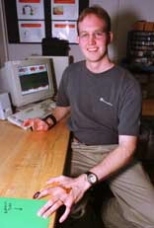Imagine navigating the Internet or typing a letter by moving your fingers without touching a mouse or keyboard.
Fingernail sensors in development at the Brit and Alex d'Arbeloff Laboratory for Information Systems and Technology could enable just such a system. They could also monitor medical parameters such as a user's pulse and respiration.
Coupled with additional sensors in a wristwatch, hearing aids, necklace and ring, MIT researchers ultimately hope to develop a "whole body observer" in which a variety of parameters are measured simultaneously, said Professor Harry Asada, director of the lab and the Ford Professor of Mechanical Engineering. Ian Hunter, the Hatsopoulos Professor of Mechanical Engineering, is co-director of the lab.
The fingernail sensors were among the d'Arbeloff Lab projects featured during two days of talks and open houses last week celebrating the lab's fifth anniversary.
During the first day's lecture series, six MIT professors explored "Grand Challenges in Information Systems and Technology for the 21st Century." For example, Professor Steven Dubowsky of mechanical engineering described the development of space explorer robots for the year 2040.
In the near future, robots will be key to exploring the universe and establishing bases for future human occupation, said Professor Dubowsky. But "space presents some very, very difficult environments" for robots, and "the current basic building blocks of robotic systems are not up to the challenges of the future," he said. For example, "even a small rock can challenge the limits of [today's robotic] rovers' mobility."
So researchers led by Professor Dubowsky are working toward "self-transforming" robotic planetary explorers that could, for example, stretch themselves up and over a given obstacle, then convert back into a more compact shape.
To that end, "we're doing a lot of simulations to evaluate the feasibility of [these] systems," he said. His team is also building component technologies such as miniature rotary joints. Professor Dubowsky predicts that within 10 years, the first of these robots will be available.
The second day of the workshop featured presentations on research through the lab's Home Automation and Healthcare Consortium. "The goal of this group is to develop information technology for the people," said Professor Asada. He went on to describe some of the 15 projects currently underway. These include the fingernail sensors and similar systems that will be connected by the "i-coin," a computer the size of a quarter that's equipped with a wireless transmitter.
"The idea is to develop a wearable health monitoring system," Professor Asada explained. The system could not only track a variety of medical parameters, but also eventually allow more complicated monitoring such as indicating whether a patient is eating properly. "Many elderly patients with memory problems such as Alzheimer's can forget to eat, or forget that they have already eaten," he said.
The open houses featured working prototypes of several of these technologies. They included a smart walker for the elderly equipped with devices such as a microphone for voice communication, health sensors and a system for navigation and obstacle avoidance.
The d'Arbeloff Lab was established in the Department of Mechanical Engineering in 1995 with a donation from Brit (SM 1961) and Alex d'Arbeloff (SB 1949, chairman of the MIT Corporation). The mission of the lab has been cross-disciplinary research and education where "information" is the catalyst that opens up new possibilities in mechanical engineering.
A version of this article appeared in MIT Tech Talk on November 1, 2000.






